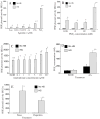Prostaglandin E2 potentiates heat shock-induced heat shock protein 72 expression in A549 cells
- PMID: 20382255
- PMCID: PMC2919605
- DOI: 10.1016/j.prostaglandins.2010.03.006
Prostaglandin E2 potentiates heat shock-induced heat shock protein 72 expression in A549 cells
Abstract
The heat shock (HS) response is an important cytoprotective response comprising the expression of heat shock proteins (HSPs) and orchestrated by the heat/stress-induced transcription factor, heat shock factor-1 (HSF-1). Previous studies suggest that the activation threshold and magnitude of the HS response may be modified by treatment with arachidonic acid (AA). We analyzed the effect of exogenous AA and its metabolites, PGE(2), LTD(4), and 15-HETE on HSF-1-dependent gene expression in A549 human respiratory epithelial-like cells. When added at 1microM, PGE(2) much more than LTD(4), but not 15-HETE increased activity of a synthetic HSF-1-dependent reporter after HS exposure (42 degrees C for 2h), but had no effect in the absence of HS. Exposing A549 cells to HS stimulated the release of PGE(2) and treatment with the cyclooxygenase inhibitor, ibuprofen, reduced HS-induced HSF-1-dependent transcription. PGE(2) increased HS-induced HSP72 mRNA and protein expression but EMSA and Western blot analysis failed to show an effect on HSF-1 DNA binding activity or post-translational modification. In summary, we showed that HS stimulates the generation of PGE(2), which augments the generation of HSPs. The clinical consequences of this pathway have yet to be determined.
Copyright 2010 Elsevier Inc. All rights reserved.
Figures



Similar articles
-
Hyperthermia in the febrile range induces HSP72 expression proportional to exposure temperature but not to HSF-1 DNA-binding activity in human lung epithelial A549 cells.Cell Stress Chaperones. 2009 Sep;14(5):499-508. doi: 10.1007/s12192-009-0103-3. Epub 2009 Feb 17. Cell Stress Chaperones. 2009. PMID: 19221897 Free PMC article.
-
Anti-apoptotic effects of L-glutamine-mediated transcriptional modulation of the heat shock protein 72 during heat shock.Gastroenterology. 2005 Jul;129(1):170-84. doi: 10.1053/j.gastro.2005.05.017. Gastroenterology. 2005. PMID: 16012946
-
Previous heat shock facilitates the glutamine-induced expression of heat-shock protein 72 in septic liver.Nutrition. 2007 Jul-Aug;23(7-8):582-8. doi: 10.1016/j.nut.2007.04.013. Nutrition. 2007. PMID: 17616344
-
[Regulation of heat shock gene expression in response to stress].Mol Biol (Mosk). 2017 May-Jun;51(3):400-417. doi: 10.7868/S0026898417020100. Mol Biol (Mosk). 2017. PMID: 28707656 Review. Russian.
-
HSF transcription factor family, heat shock response, and protein intrinsic disorder.Curr Protein Pept Sci. 2012 Feb;13(1):86-103. doi: 10.2174/138920312799277956. Curr Protein Pept Sci. 2012. PMID: 22044151 Review.
Cited by
-
Modulation of adrenocorticotrophin hormone (ACTH)-induced expression of stress-related genes by PUFA in inter-renal cells from European sea bass (Dicentrarchus labrax).J Nutr Sci. 2015 May 4;4:e16. doi: 10.1017/jns.2015.6. eCollection 2015. J Nutr Sci. 2015. PMID: 26090096 Free PMC article.
-
Distinct, gene-specific effect of heat shock on heat shock factor-1 recruitment and gene expression of CXC chemokine genes.Cytokine. 2011 Apr;54(1):61-7. doi: 10.1016/j.cyto.2010.12.017. Epub 2011 Jan 26. Cytokine. 2011. PMID: 21266308 Free PMC article.
-
Bacterial lipopolysaccharide augments febrile-range hyperthermia-induced heat shock protein 70 expression and extracellular release in human THP1 cells.PLoS One. 2015 Feb 6;10(2):e0118010. doi: 10.1371/journal.pone.0118010. eCollection 2015. PLoS One. 2015. PMID: 25659128 Free PMC article.
-
Modulation of the Expression of Components of the Stress Response by Dietary Arachidonic Acid in European Sea Bass (Dicentrarchus labrax) Larvae.Lipids. 2015 Oct;50(10):1029-41. doi: 10.1007/s11745-015-4057-1. Epub 2015 Aug 2. Lipids. 2015. PMID: 26233819
-
Pain Relief with Wet Cupping Therapy in Rats is Mediated by Heat Shock Protein 70 and ß-Endorphin.Iran J Med Sci. 2017 Jul;42(4):384-391. Iran J Med Sci. 2017. PMID: 28761205 Free PMC article.
References
-
- Feder ME, Hofmann GE. Heat-shock proteins, molecular chaperones, and the stress response: evolutionary and ecological physiology. Annu Rev Physiol. 1999;61:243–82. - PubMed
-
- Sarge KD, Murphy SP, Morimoto RI. Activation of heat shock gene transcription by heat shock factor 1 involves oligomerization, acquisition of DNA-binding activity, and nuclear localization and can occur in the absence of stress [published errata appear in Mol Cell Biol 1993 May;13(5):3122–3 and 1993 Jun;13(6):3838–9] Mol Cell Biol. 1993;13(3):1392–407. - PMC - PubMed
-
- McMillan DR, Xiao X, Shao L, Graves K, Benjamin IJ. Targeted disruption of heat shock transcription factor 1 abolishes thermotolerance and protection against heat-inducible apoptosis. J Biol Chem. 1998;273(13):7523–8. - PubMed
-
- Wang CY, Mayo MW, Baldwin ASJscx, et al. TNF- and cancer therapy-induced apoptosis: potentiation by inhibition of NF-kappaB. Science. 1996;274:784–7. - PubMed
Publication types
MeSH terms
Substances
Grants and funding
LinkOut - more resources
Full Text Sources

